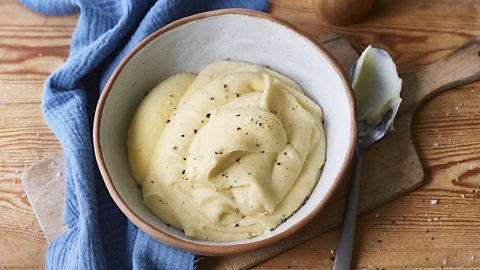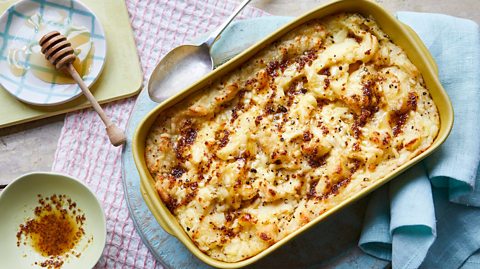The strange trick that will take your mash to the next level
WeÔÇÖre willing to bet youÔÇÖre mashing your potatoes all wrong. HereÔÇÖs the secret to getting restaurant-worthy mashed potato at home, direct from the Potato Queen herself.
By Poppy, O'Toole, Potato Queen
Dolloped next to a joint of meat, making a bed for some bangers or spread on top of a fish pie, mashed potato is the hero of many a comfort-food dish. At this time of year in particular, itÔÇÖs a favourite side to dial up those warm and cosy feels.

When it comes to achieving that perfect mash though, people rely on loads of different methods ÔÇô each household has their own way of doing it.
IÔÇÖve delved so heavily into potato recipes over the last two years that I have been dubbed the ÔÇÿPotato QueenÔÇÖ online. My videos on social media have had over 200 million views and even Nigella called me the ÔÇÿHigh Priestess of potatoÔÇÖ.
With this title, however, comes great responsibility. So, itÔÇÖs not without a significant amount of research and experimentation ÔÇô not to mention months of strenuous, in-depth potato eating ÔÇô that IÔÇÖm about to tell you the best way to make mashed potato, to get it perfectly silky and smooth and raise the bar for this most worthy side dish.
You might just be surprised by my fool-proof method too, which involves using an everyday household item to get the best texture. (Hint: itÔÇÖs not a potato masher.)
Once youÔÇÖve learned all there is to learn about mash, vote in our poll at the bottom of the page to tell us which style of mash youÔÇÖre going to make next. YouÔÇÖll even get to see how popular your choice is.
To lump or not to lump
Having been a chef for a decade, itÔÇÖs been drilled into me to remove any and every suggestion of a lump from mashed potato (or pommes pur├®e, as itÔÇÖs called in the swankier places IÔÇÖve worked, where itÔÇÖs swiped across your plate and sold at quadruple the price). Lumps have no place in professional mash and anything less than a velvety-smooth texture is a sin.
However, IÔÇÖve discovered through online comments that, unbeknownst to us professionals, there are people up and down the country who like their mash lumpy. This under-represented section of the population actively chooses to resist fully mashing their spuds, preferring to give them more of a casual crush instead.
Personally, the thought of a lumpy mashed potato takes me back to school dinners. And while I was 10 years old, 10 stone and certainly not complaining (instead youÔÇÖd find me finishing off the lumpy mash my friends had left), that texture isnÔÇÖt something IÔÇÖd strive for when making my own.
For me, itÔÇÖs all about the smoothness ÔÇô so much so that IÔÇÖve thoroughly tested different types of potato, dairy and equipment all to work out how to make the creamiest lumpless mashed potato possible. (Sorry lump lovers ÔÇô youÔÇÖll have no interest in what follows.)

The best type of potato for mash
The first big choice that will determine the success of your mash is the variety of potato. Only last week, and even with the crown of potato royalty weighing heavy on my head, I mashed red skin potatoes that were just simply too waxy. In the end it turned out I had made ÔÇô please forgive me ÔÇô gloopy mashed potato. It happens to the best of us.
Waxy potatoes are a no-no, meaning anything like a Charlotte, Ratte, Desiree or Jersey Royal is strictly ruled out. They are more likely to hold their shape, so when you start to break down the cell walls of the potato through boiling and mashing, they give you more of a wallpaper paste than a perfectly fluffy mash.
For my money, you want a starchy potato. These require a lot less encouragement to break down, meaning less starch is released. The result? A fluffier mash. The varieties you should be looking for are Maris Pipers, King Edwards or Vivaldi.
IÔÇÖve said it before and IÔÇÖll say it again: my love language is the Maris Piper. IÔÇÖll always pick her for a mash (as well as for roast potatoes) and she's never let me down.
Skin on?
Alongside the lump-lovers, there are people like to keep the skin on for mash. This gives a more textured result with a different mouthfeel ÔÇô and it looks distinctive, too. Skin-on mash also has extra as a lot of the good stuff is in the skin. There's also less waste with this method.
If IÔÇÖm honest, my perfect mash has no skin in. This doesnÔÇÖt mean your potato peelings should go in the bin, though. I always keep them aside to use in a veggie stock or a soup, or even fry them for a crispy snack.
Cream or milk?
Butter is essential for mash, yet there is debate (who knew there were so many contentious potato-related topics?) whether you should add cream or milk. I always go for cream, in particular double cream, as I feel it adds a richness, depth and creaminess that is just sublime. Milk will still improve texture, just with less of the indulgence. But who doesnÔÇÖt want a sprinkling of decadence in their mashed potato?
Throw out the masher
Most people in the UK will have a potato masher ÔÇô that decades-old utensil that you can never find in the drawer. However, hereÔÇÖs where things get juicy: I don't think that masher is doing your potatoes justice.
IÔÇÖve found that, using a masher, it takes a lot more effort to get perfectly smooth mash. Plus, the more you have to mash to get the right texture, the greater the risk of gloopiness. And thereÔÇÖs still always the risk of leaving lumps behind.
My answer? Throw out the masher and use a sieve instead. With spatula in hand, pass the boiled potatoes, mixed with a generous amount of butter, through the sieve only once. It means youÔÇÖll get faultlessly smooth results without overworking your spuds. I know you might be questioning my sanity here, but I get endless messages from people who try this technique and never look back. Trust me when I say itÔÇÖs time to join Team Sieve.
I recommend a sieve because almost everyone has one, but a potato ricer also works well. A ricer is essentially a larger garlic press, but for potatoes. It works the same as a sieve ÔÇô in that the potatoes are pushed through lots of tiny holes to make sure the result is totally lump-free ÔÇô but it only does one job in the kitchen. A sieve also does, you know, sieving, as well.
PoppyÔÇÖs five fool-proof tips for the perfect mash
- When cutting your spuds for mash, make sure you cut them into even chunks with similar size and thickness so that they cook evenly when boiled.
- Put your potatoes in cold, heavily salted water and bring it up to the boil (rather than adding them to already-boiling water). This will stop the potatoes overcooking on the outside and cook them more evenly. If you salt them during boiling, you do not need to season them at the end.
- Make sure you stream dry your potatoes after boiling by leaving them in the colander, on top of the pan youÔÇÖve just boiled them in, with a tea towel on top. This will give a fluffier result when you mash them.
- Add butter to your spuds just before you pass them through the sieve.
- Heat up your cream or milk prior to adding it to your sieved mash so that it will combine more easily.
And there you have it. Whether your mash is intended for Sunday dinner, Tuesday teatime or just breakfast (letÔÇÖs normalise this), itÔÇÖs time to perfect it. Give it a go, then feel free to get in touch to tell me how your life has changed.
Now give your dream mash a go:
Originally published June 2022